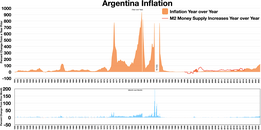
Back التاريخ الاقتصادي للأرجنتين Arabic Hospodářské dějiny Argentiny Czech Historia económica de Argentina Spanish היסטוריה כלכלית של ארגנטינה HE अर्जेंटीना का आर्थिक इतिहास Hindi Արգենտինայի տնտեսական պատմություն Armenian Sejarah ekonomi Argentina ID Storia economica dell'Argentina Italian アルゼンチン経済の歴史 Japanese Экономическая история Аргентины Russian
| History of Argentina |
|---|
 |
|
|




The economic history of Argentina is one of the most studied, owing to the "Argentine paradox". As a country, it had achieved advanced development in the early 20th century but experienced a reversal relative to other developed economies, which inspired an enormous wealth of literature and diverse analysis on the causes of this relative decline.[1] Since independence from Spain in 1816, the country has defaulted on its debt nine times. Inflation has often risen to the double digits, even as high as 5,000%, resulting in several large currency devaluations.
Argentina possesses definite comparative advantages in agriculture because the country is endowed with a vast amount of highly fertile land.[2] Between 1860 and 1930, exploitation of the rich land of the pampas strongly pushed economic growth.[3] During the first three decades of the 20th century, Argentina outgrew Canada and Australia in population, total income, and per capita income.[3] By 1913, Argentina was among the world's ten wealthiest states per capita.[4]
Beginning in the 1930s, the Argentine economy deteriorated notably.[3] The single most important factor in this decline has been political instability since 1930 when a military junta took power, ending seven decades of civilian constitutional government.[5] In macroeconomic terms, Argentina was one of the most stable and conservative countries until the Great Depression, after which it turned into one of the most unstable.[6] Despite this, up until 1962, the Argentine per capita GDP was higher than that of Austria, Italy, Japan, and of its former colonial master, Spain.[7][better source needed] Successive governments from the 1930s to the 1970s pursued a strategy of import substitution to achieve industrial self-sufficiency, but the government's encouragement of industrial growth diverted investment from agricultural production, which fell dramatically.[8]
The era of import substitution ended in 1976, but at the same time growing government spending, large wage increases, and inefficient production created a chronic inflation that rose through the 1980s.[8] The measures enacted during the last dictatorship also contributed to the huge foreign debt by the late 1980s which became equivalent to three-fourths of the GNP.[8]
In the early 1990s, the government reined in inflation by making the peso equal in value to the U.S. dollar and privatized numerous state-run companies using part of the proceeds to reduce the national debt.[8] However, a sustained recession at the turn of the 21st century culminated in a default, and the government again devalued the peso.[8] By 2005 the economy had recovered,[8] but the country again defaulted in 2014 and 2020.[9][10]
- ^ della Paolera, Gerardo; Taylor, Alan M. (October 1997). "Finance and Development in an Emerging Market: Argentina and the Interwar Period". NBER Working Paper No. 6236: 1. doi:10.3386/w6236.
- ^ Galiani & Gerchunoff 2002, p. 4.
- ^ a b c Yair Mundlak; Domingo Cavallo; Roberto Domenech (1989). Agriculture and economic growth in Argentina, 1913–84. International Food Policy Research Institute. p. 12. ISBN 978-0896290785.
- ^ Spruk, Rok (2019). "The rise and fall of Argentina". Latin American Economic Review. 28 (1): 16. doi:10.1186/s40503-019-0076-2. ISSN 2196-436X.
- ^ Cite error: The named reference
econbscwas invoked but never defined (see the help page). - ^ Della Paolera & Taylor 2003, p. 87.
- ^ GDP per capita graph 1960–2015 by Google Public Data Explorer, sources from World Bank
- ^ a b c d e f Cite error: The named reference
britargwas invoked but never defined (see the help page). - ^ Alexandra Stevenson; Irene Caselli (July 31, 2014). "Argentina Is in Default, and Also Maybe in Denial". NYTimes.com. Retrieved August 1, 2014.
- ^ Politi, Daniel (May 22, 2020). "Argentina Tries to Escape Default as It Misses Bond Payment". The New York Times. ISSN 0362-4331. Retrieved May 24, 2020.
© MMXXIII Rich X Search. We shall prevail. All rights reserved. Rich X Search